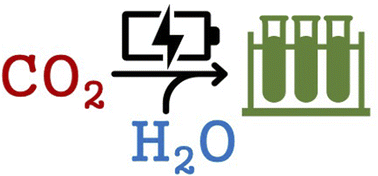Enabling technologies for the continuous electrically driven conversion of CO2 and water to multi-carbon products at high current densities†
Abstract
Herein, we demonstrate greatly improved conversion of CO2 using a gas diffusion electrode (GDE) with flowing electrolyte configuration for CO2 gas delivery in combination with a high surface area nickel phosphide electrocatalyst. This configuration achieves 40–50% selectivity for total carbon products over H2 formation (HER) at total current densities ranging from 50 to 300 mA cm−2. We developed a soft-templating method using CTAB detergent micelles for synthesis of phase-pure Ni2P, achieving a 260-fold larger surface area (BET) and porous sponge-like morphology that produces stable currents. This catalyst produces mainly one C-product, methylglyoxal (MG, C3H4O2) with 38–47% overall selectivity, the highest reported selectivity for a 12-electron reduction product. The versatile soft-templating method for electrocatalyst synthesis uses low-temperature (185 °C) that is permissive for incorporation of co-catalysts that are otherwise destroyed by the high temperatures used in traditional solid-state synthesis (SSS). The non-porous Ni2P-SSS catalyst produces mainly H2 at these current densities. Achieving these high currents and C/H selectivity benefits from use of hydrophobic polymers as co-catalyst binders (cationic = Nafion, anionic = PFAEM and neutral = PTFE) to improve CO2 conversion. PFAEM is the better ionomer for the CO2RR at high current density, postulated as due to suppressing CO2 conversion to inactive bicarbonate. Precipitation of the carbon products as a polycarbonate polymer occurs at high currents.



 Please wait while we load your content...
Please wait while we load your content...